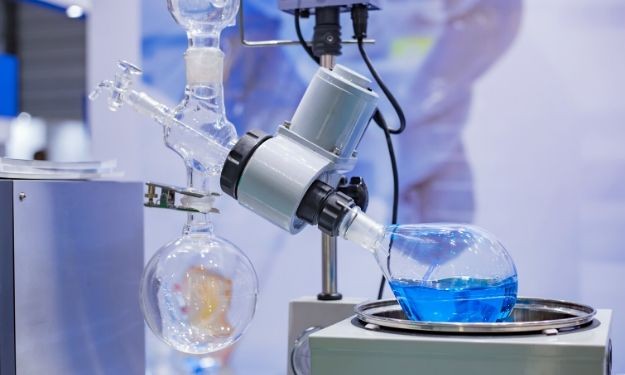Bumping and foaming in a rotovap occur when the liquid in the flask is heated and the volatile components start to evaporate, creating bubbles that rise to the surface. The bubbles can become so abundant that they cause the liquid to boil and splatter, which is known as bumping. Foaming occurs when the liquid forms a stable foam on the surface that can also lead to sample loss and contamination.
How to minimize Bumping and Foaming
About Bumping
Bumping is a common problem that occurs during rotovap distillation. It is caused by the rapid boiling of a sample, which leads to the formation of bubbles that can cause the sample to splash out of the flask. This can be caused by several factors, such as heating the sample too quickly or applying too strong of a vacuum.
When the evaporation flask is more than half full, the chances of bumping causing damage and splashes into the rotovap are increased. To prevent this, it is important to go slow when starting the distillation process and to start with a low vacuum. It is also important to visually inspect the sample while decreasing the pressure to ensure that bumping does not occur.
Similarly, when using a water bath to heat the sample, it is important not to start with too high of a temperature. It is best to start with a lower temperature and to keep monitoring the sample while gradually increasing the temperature of the water bath. This will help prevent the sample from overheating and boiling rapidly, which can lead to bumping.
About Foaming
Foaming is a common problem that occurs during rotovap distillation and can be caused by surfactants present in the sample. Unlike bumping, foaming is much harder to completely avoid, but it can be minimized by following certain precautions.
One way to minimize foaming is by slowly applying the vacuum, visually monitoring the sample and opening and closing the stopcock to release the vacuum whenever foam appears. This will help to minimize the amount of foam that is created and keep it within the evaporation flask.
Another way to deal with foaming issues is by adding anti-foam agents to the sample. These agents can help to reduce the amount of foam that is created and keep it from escaping the evaporation flask. Additionally, using a larger flask can also help to keep the foam within the flask and prevent it from spilling over.
For bumping, adding agents such as boiling chips can help to make the boiling more uniform, which can help to prevent the sample from splashing out of the flask.
To further prevent contamination and sample loss from bumping or foaming, a bump trap or foam brake can be installed. These are secondary flasks that are designed to collect any sample that bumps or foams over, avoiding product loss and contamination of the rotovap.
Advanced rotovaps like the KE series Rotary Evaporator from Kindle Tech are equipped with sensors that monitor the vapor pressure and adjust the vacuum automatically, taking care of bumping and foaming without extra effort on your part.
Conclusion
bumping and foaming are common problems that can occur during rotovap distillation. Bumping is caused by the rapid boiling of a sample and can be prevented by starting the distillation process with a low vacuum and low temperature, visually monitoring the sample, and gradually increasing the vacuum and temperature.
Foaming is caused by surfactants present in the sample, and can be minimized by slowly applying vacuum, visually monitoring the sample, adding anti-foam agents, using a larger flask and using a bump trap or foam brake to prevent contamination and sample loss.
Advanced rotovaps are equipped with sensors that automatically adjust the vacuum to minimize bumping and foaming.
CONTACT US FOR A FREE CONSULTATION
KINTEK LAB SOLUTION's products and services have been recognized by customers around the world. Our staff will be happy to assist with any inquiry you might have. Contact us for a free consultation and talk to a product specialist to find the most suitable solution for your application needs!











